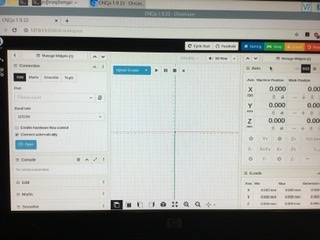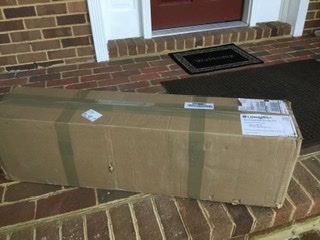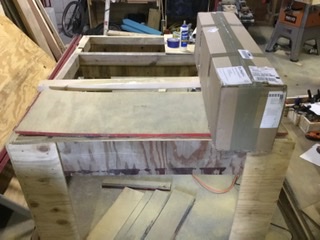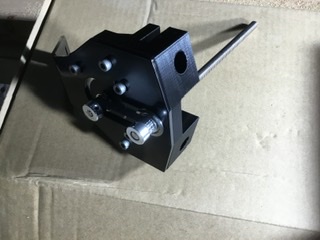I’m curious having never had a CNC but having done woodworking for a long time and finally ran across the Longmill so I ordered it. I have a lot of projects to do that don’t involve woodworking but I have to build a porch railing for my porch which is about 30 ft of open space. I was thinking that I would create posts with designs so the porch would be unique, using badges, cutouts and screens as well as try to make the railing with 3D fluer-de-lis or something along those lines. I write to solicit advice or suggestions. Of maybe even criticism for the scope of the project. I would understand that because I’ve not tried this technology before and other that having built a table to put the CNC on (it doesn’t have a top yet, but is 5’ x 4’) I am wholly unprepared for this. I don’t have any toolchain planned or hardware to input the g-code into the machine (considering the Rasberry Pi thing). Part of the problem for me is that I am very hands on and like to solve problems as they come up, but I also like to be slightly prepared but not knowing anything means that I won’t know what I don’t have until I try to make something. But back to my railing project. Any advice or thoughts? It may be assumed that I know nothing. Motivation for this is to create something beautiful and unique. Porches all look the same and I tend to prefer to not look like everyone else.
@nuc_65 Daniel: It is certainly possible to mill designs into posts.
Much will depend on the cad/cam software that you choose. There are good free versions available, including one created by Chris - one of our hosts. Recommended paid programs would include those from Vectric. They are excellent, but pricey.
As to a machine to send the gcode to the Mill, I am using a windows PC, so I cannot be much help with using a rasberry pi. I assume that it will run linux, yes? Again, you have options as to control software. The Sienci page lists several to choose from. I am getting good results from UGS, now that I have installed a more recent version than the one that I started with.
Take a look at Mark Lindsay CNC on youtube. He has a series on vcarve for beginners that is excellent. Even if you don’t end up using the same program, the concepts will be very similar. CNCNutz on youtube is another good resource.
This forum is another excellent source of good information. There are many users here that have tried projects similar to the one you are thinking of. Don’t hesitate to ask questions.
As Grant said, it’s definitely possible and a really nice use of a smaller CNC like the Longmill.
Another software package you may want to consider, that is free for personal use but is actually quite an expensive commercial package (so it’s wonderful they let us use it for free) is Fusion 360. However, the initial learning curve is steep. If you try to get only the answer you need and push ahead without doing some basic tutorials first, it will be infuriating (my mistake!). Now that I’ve discovered the “learn fusion 360 or die trying” series by Paul Worter (?) on YouTube, and having done the first 5 videos, it’s really enjoyable to use. That being said, I suggest starting with the more basic tools like CAMLab and getting comfortable then working up to 360. You’ll get to finished projects faster while you learn the basic concepts of CNC.
The Pi will certainly work. I’m planning on moving to a Pi + cncjs setup soon. cncjs is a “sender” that transmits the file to the Longboard (the controller attached to the Longmill). UGS is the recommended sender to start with and it works well enough and I’ve done lots of projects with it, but some of the limitations I’ve run in to as I got more comfortable have caused me to want to try something new. Even so, I’d still recommended starting with UGS as well since most anyone here who will offer to assist you will be familiar with it.
With regards to the porch ideas specifically, one thing to consider is whether or not you are going to mill the spindles directly or you want to make pieces to attach to the spindles after you build the porch. Milling directly has some challenges, depending on the thickness of the material you are working with.
I’ve done some x4 milling and how you hold down the workpiece as well as the Z depth/bit depth can come in to play and cause delays and frustrations. I’ve got a work holding solution now and I’m much more aware of the Z travel considerations (and I have a sensor for Z up travel but not Z down). I’d suggest considering building the porch normally and planning on attaching the details after the fact where feasible. It will just be a lot easier and flexible and you can cut your designs out of your stock so you can just screw down the edges outside your toolpaths, rather than wondering how you’ll attach boards you don’t want screw holes in.
-Jeff
Thank you for the responses. I don’t plan on carving into the posts/spindles, but to replace them with panels. I hadn’t thought about the thickness of the material and now I’m concerned about the depth of cut that I will need to make. What is the maximum depth of cut I can make with a longmill? It seems that the depth is more limited by bit and router/spindle clearance then by z direction travel. You do give me food for thought which is greatly appreciated.
I am thinking about carving into the main posts with some small 3D design or maybe cutting some 3D items and adding them to the posts. I won’t have the longmill for another month probably so I have some time to study up and plan some more.
I plan on posting my attempt mostly because I don’t see much in the way of integrated projects just singular items. I think the CNC has a possibility to make unique upgrades for people. Custom cabinets, crown moldings, porch railings, fireplace mantels. I think it will be a learning experience and as you provided maybe people will have good advice for me or questions that will help me work through any issues.
@nuc_65 Daniel: Not that it matters a great deal, but I am confused by your post. 
You say that you don’ t plan on carving into the posts/spindles. But, then you say you are thinking about carving into the main posts.
You are right in thinking that you main limitation to depth is the cutting length of your bits. I have made inlaid boxes and the issue is always that I cannot mill out the exterior to the full depth. The Z travel accommodates it, but, at just over 2" deep, I do not have a 1/4" mill that has a cutting length that will allow it. I end up going as deep as I can, then doing a rough cut on my band saw to get close to the diameter and finally using a flush trim bit on my router table to take out the rest. I believe that I have seen bits with longer cutting lengths. I have not bought any.
If you do decide to carve into posts, I would not think that you would want to carve deeper than a standard bit allows, but that would be your choice based on your design. Jeff mentioned hold down considerations if you want to go this way. I’ve had success carving picture frame lengths, holding the pieces down with blue tape and CA glue. I have also had success running a fillet of hot melt glue along the length of the material. I made some vacuum hold downs that attach to my spoil board tracks. I already had a vacuum pump for vacuum chucking on my lathe. Now, I just run a hose to the vacuum hold downs and I can do carving projects like you are considering.
I’ll be very interested to see your projects. You mention crown moulding. I have done short lengths using the moulding toolpath in VCarvePro. This has allowed us to match existing, older profiles to repair damaged moulding.
This will be great to see and is actually where a CNC really shines - doing things repeatedly (even if each item has small customizations).
Fusion 360 is a parametric design platform, which means you can set and name variables and adjust them to create similar but different versions of things that are adjusted to various dimensions that are interrelated. So you could design a book case that is available in 3 widths for example. Of design your panels and detailing and make various versions quite easily. It may be worth a look.
The most repetition I’ve done so far was cutting four identical arms to make 2x paddle board mounts for the garden fence. I have to admit it was pretty satisfying to design it once and run it off four times.
-Jeff
I don’t have it here to confirm but I do have a single 3/8" down cut bit and it is 1.5" I think. And from Amana if I’m remembering correctly. I used it to great effect with the 2x4s.
-Jeff
@jwoody18 I’m limited to 1/4" shank - not having a 3/8" collet for my Makita - and the longest cutting length that I have is 1.25", I think. I don’t have many projects that need more than that. Where I have difficulties is with 1/8" shaft bits.
I apologize for the poorly worded post (haha, bad joke). When I started writing this I thought that post meant spindle or the supports for the railing. Posts are supports for the beams and spindles support the railing to my way of thinking. I did mean that I don’t have any real plans to cut into the posts but then after thinking about it I might get carried away and carve a little design into the posts. I agree that for the posts only a slight carve into the surface so that I don’t affect the structural integrity would be prudent.
As far as the spindles go my current thought is to not have anything that looks like a spindle but instead to have panels that will have designs that replace the spindles and support the railing at the same time. I do think that a 1 1/2" thickness would be my target but I’ll have to see what I can make.
I have been thinking about the length of the railing and being able to tile the railing to make a pattern (like crown molding) repeatable along the 10’ length. I’m still fighting a learning curve for hardware and software to accomplish this but I’m not discouraged and looking forward to making mistakes (although hopefully not too many). Hold-down on the work pieces is still not defined.
Appreciate all your inputs, thoughts and comments they help me think out where I am headed.
I’m admittingly a little afraid of Fusion 360. I looked at a tutorial and watched a couple of ‘beginner’ you tube videos and felt way out of my depth. I’m not sure how to ‘export’ the g-code once you have a design but another question is how do I take a 3D model and make slices of it to cut out layers that I can glue into a full 3D item? I watched a you tube video and lets say I make a 3D image of something in mesh maker and then put it in Fusion360 and then slice it and cut layers of plywood that can then be glued together to make a full 3d image of whatever I would like. That would be awesome and would expand what I could do.
Adding to my progress I did order an ABOX Rasberry Pi kit from Amazon. I have a monitor, extra keyboard and mouse already on hand. The table I made is 4’ by 5’6" so plenty of room on the table for the Longmill which will arrive some day.
I need to read about the difference between UGS and CNCjs. If UGS is limited for some reason I would rather just start with the CNCjs then switch at a later date.

I made a start with setting up my Rasberry Pi with CNCjs and succeeded in at least starting it up. Some more reading to see how to open G code files from my computer or perhaps transfer files. My son thought the pi was the coolest thing he’d seen.
If you think thru the full process you may/might determine that part of the workflow can be done through other woodworking processes. I’ve tried to do everything on the cnc only to realise an easier approach would be to combine the cnc work with other processes as Grant alludes to. Sometimes we get obsessed with one thing when another is more appropriate. I look forward to seeing your project as it progresses.
Thank you for pointing that out. I agree that there are a number of parts and pieces that I will use other tools for. I don’t know yet how much of what that will be but I will try to post as I go.
Still anxiously awaiting my longmill. I’ve sketched a few ideas and thrown a couple out. I’m working on proportions and a skeleton for support. The biggest struggle for me is whether to make it symmetrical. I have 3 ten foot spaces to fill and then two much smaller rails, after I install half posts for the steps. I hadn’t gotten to thinking about the steps and angles going down to the ground posts. I’ve read a little about conventional building for porch railing.
Received Longmill today! Feels like Christmas. Managed to put a part together.



